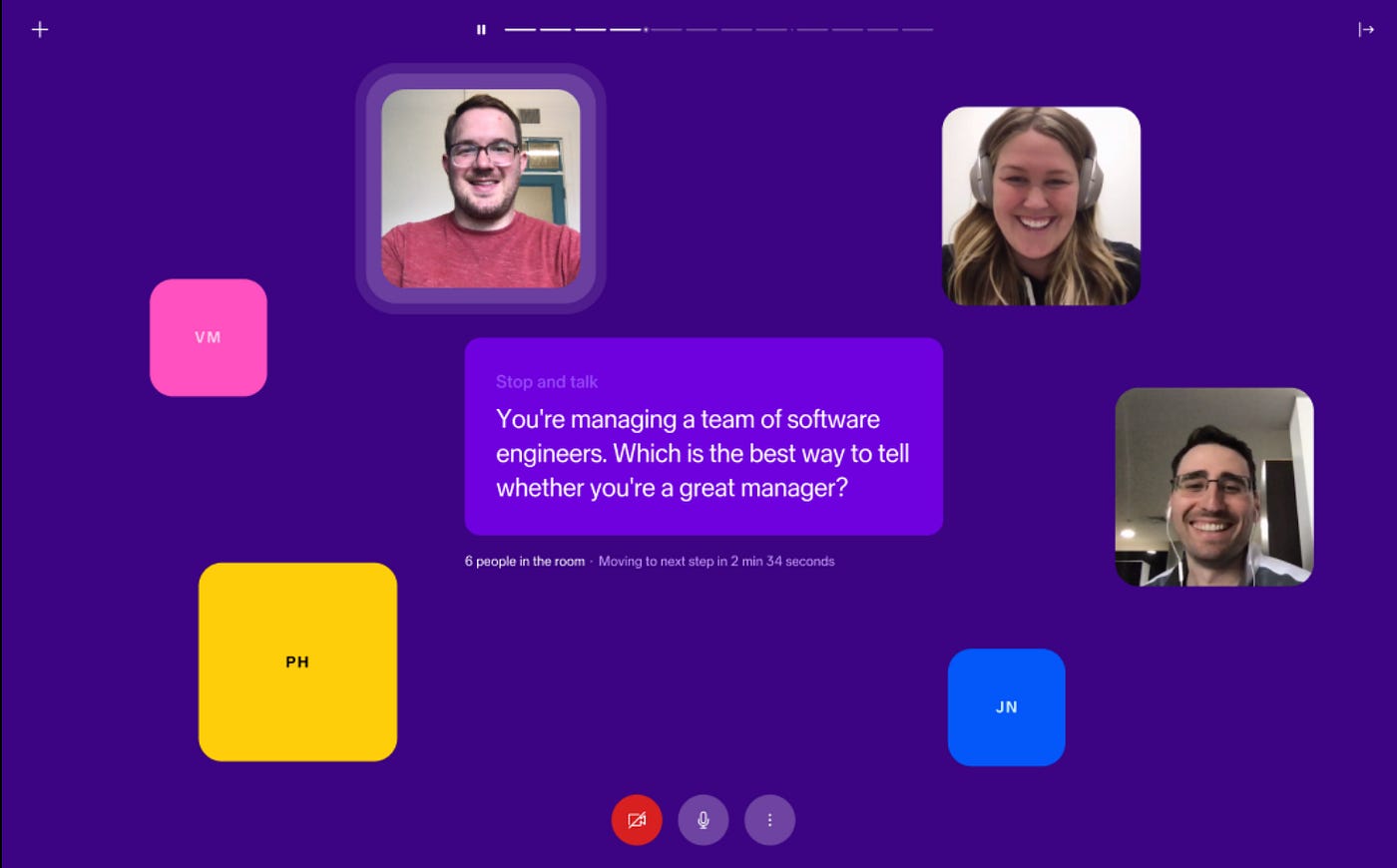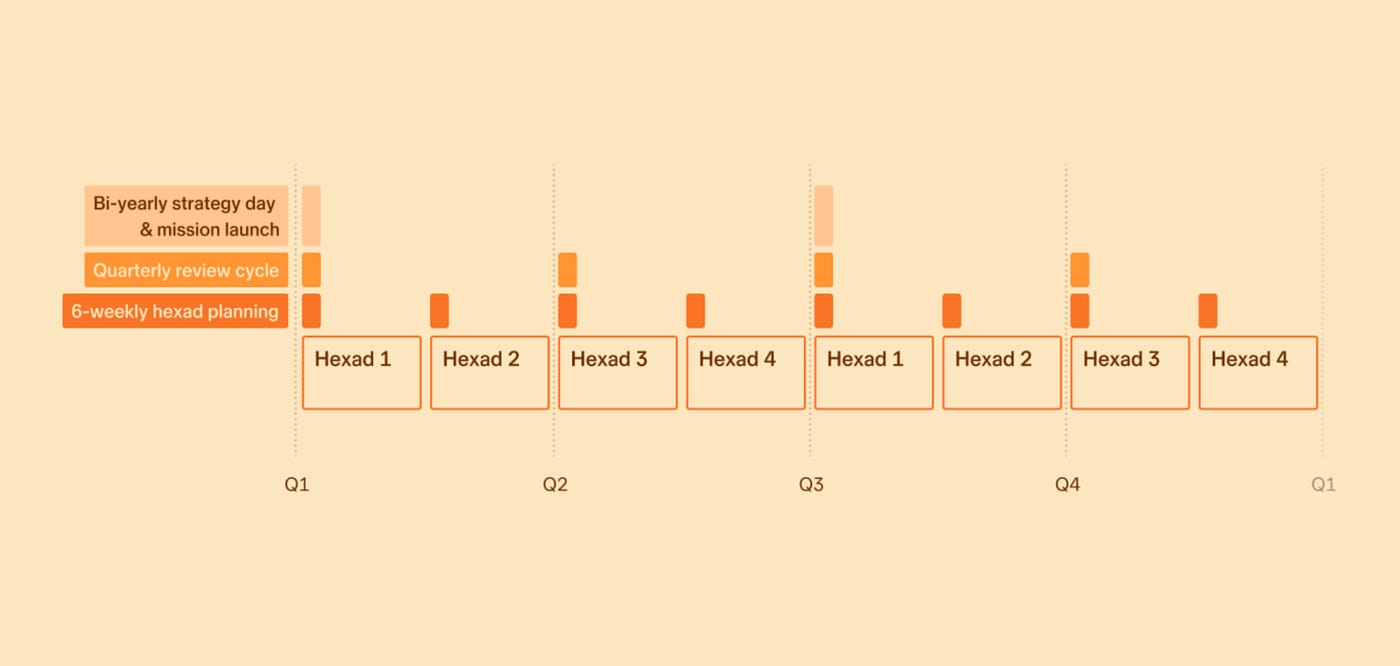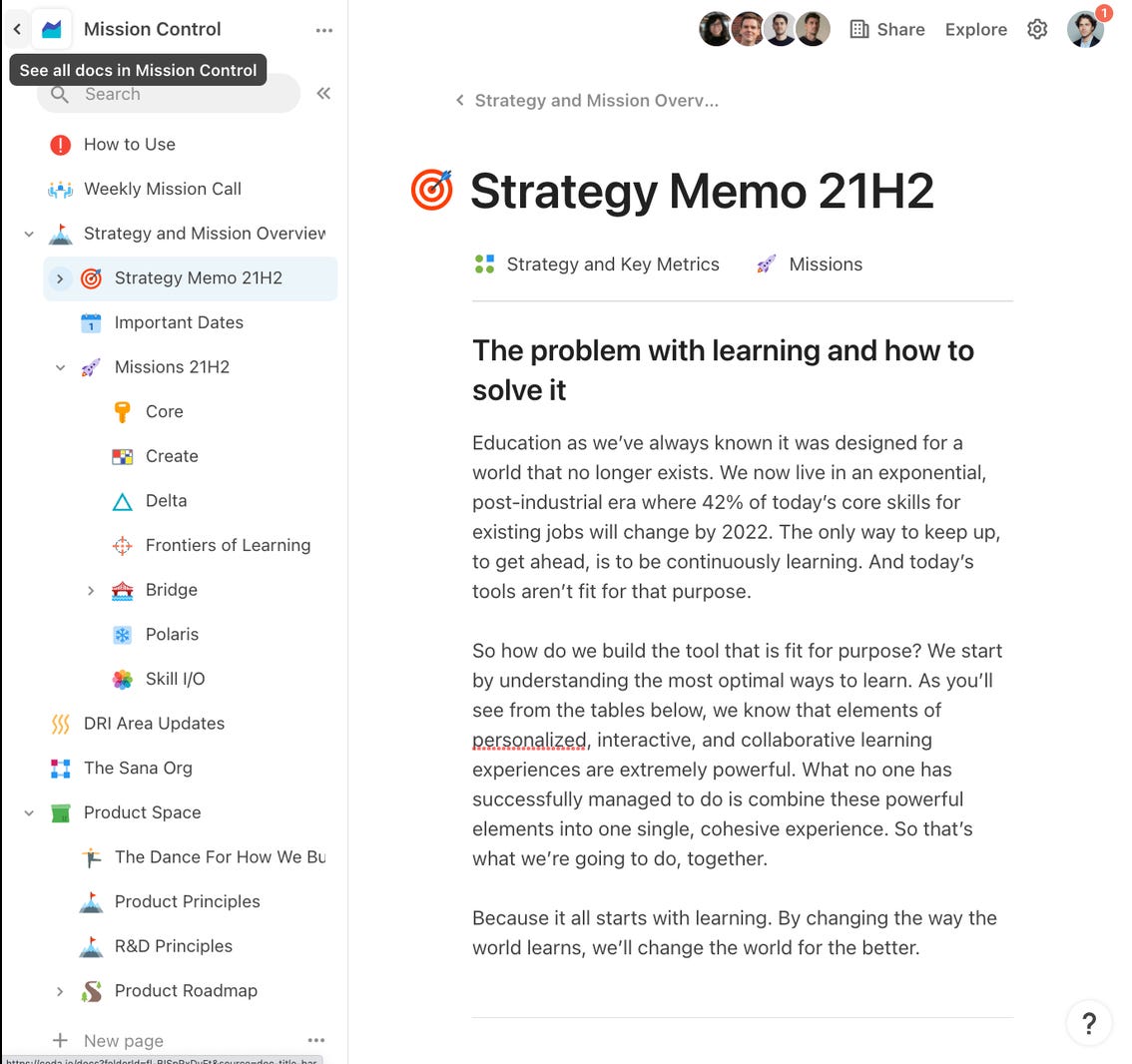Case study: Sana's vision
How Sana Labs avoided incrementalism and focused on product vision to find product-market fit.
👋 Last week the AI learning company Sana Labs raised another $55m to further their ambitious vision of personalised learning and helping people to access knowledge.
Three years ago, Joel Hellermark, their founder and CEO shared with me how they went about finding product-market fit by taking a vision-led approach. I’m publishing it again here today as it provides an interesting counterpoint to the popular Lean methodology.
We’re also running a meet up in London on Tues, 26 November. Sign up here. And offering 10% early bird discounts on our cohort programmes starting in the new year.
“I really hated it,” laughs Joel, founder and CEO of Sana Labs. He’s laughing but it’s clear he means it. “When you start a tech company, everyone tells you to read it. The Lean Startup. But I hated every page of that book. I thought there must be an alternative approach.”
Joel is now a passionate advocate for the vision-led approach, something he sees as the antithesis to Eric Ries’ the Lean Startup. It has served him well in getting Sana Labs to product-market fit. They have now raised $130m in funding to keep building their vision of an operating system for personalised learning, including a Learning Platform and, since the emergency of gen AI, an Assistant Platform.
“Instead of finding the product through discovery and iteration the goal is to reverse engineer the vision,” he explains. “If you take an incremental, discovery-led approach, then you might find yourself with product-market fit in a local maximum, building a company that you don’t want to lead.”
Cathedrals to bricks
So how does the vision-led approach work?
Joel tells the parable of the three bricklayers. When asked what they are doing one answers, “I’m a bricklayer, I’m working hard to feed my family.” The second answers, “I’m a builder, I’m building a wall.” And the third answers, “I’m a cathedral builder, I’m building a cathedral.”
“When we started Sana, for us this story encapsulated this vision-led approach and became a core value of the company,” says Joel. “We were very inspired by this, how can we ensure that everyone says they are building a cathedral. And more specifically, how can we make sure they know the breakdown from the cathedral to the bricks.”
He tells another story about how a friend that was working for SpaceX was able to explain in detail the different steps from what he was doing to the ultimate goal of landing on Mars. “He knew exactly how he contributed to this silly-ambitious mission.”
This is his first piece of advice: “The first goal of a product founder: to align everyone on ‘the cathedral’. And then enable everyone to make those connections to their day-to-day work.”
Exploration vs exploitation
“It’s very easy to get stuck in incrementalism,” says Joel. “When we set out and built the first iteration of our product, all our team then thought about was improving that product. It was just incremental improvements,” says Joel.
They had achieved traction with some initial customers in their home market of Sweden, but Joel wasn’t sure that it would necessarily translate further into what he calls ‘the global maximum’.
“I thought we could be stuck iterating in a completely different area of the problem space than where we should be. We needed to understand was this a local maximum or did it apply globally?”
This was a danger that Sana decided to consciously design their way out of. “How we did that was by knowing when we were in ‘exploration’ mode and when we were in ‘exploitation’ mode,” explains Joel. “We made it clear if we were looking for big deltas in the design or if we were looking for fine tuning.”
Generally, before you reach product-market fit, you’re much better off exploring than exploiting, reckons Joel.
“There’s a big risk in iterating something that doesn’t have product-market fit. So I started to ask myself, how big were the deltas between iterations? As soon as I was getting a third iteration on the sign up flow, I knew we were in a bad place. But when I saw big deltas in the designs and we were exploring the global maximum of the vision, I knew that we were on the right track.”
Another practical example of this, was inspired by an approach pioneered by Deepmind. When Deepmind were trying to create an AI that could play Go, they had 50 engineers. Instead of dividing up the problem, they split them into 10 teams, put up a dashboard and got the teams to compete. Once they had an outlier on the metrics, they then moved all the teams to work on the winning approach.
“I found that to be a really interesting idea: really explore the problem space before you put all of your resources behind a single approach. This is something that we now do with big technical challenges.”
Snow White and the Hamming question
So how do you go about practically crafting a vision?
Joel has found it useful to ask the Hamming Question.
The mathematician Richard Hamming was known to ask experts in other areas, “What is the most important problem in your field?” And then follow up with, “Why aren’t you working on it?”
“I ask my direct reports this question every week. And it’s their answers to this question that informs our next big bets,” says Joel.
For each big bet, they make trailers. Like with a movie trailer, it captures the main highlights of the product.
“We put this full encapsulation of the product in front of customers,” explains Joel. “We do this, rather than show them 10% of your vision like you would do with a Minimum Viable Product. Then we explore which segments of the trailer they are most interested in and then start evolving from there.”
He says that this stops you from jumping into the details, before you understand the high level view. “The trailers allowed us to put prototypes in front of customers and learn from that before getting into the details.”
Joel also cites AirBnB’s ‘Snow White’ vision as an influence on this.
Airbnb’s founder Brian Chesky had been reading Walt Disney’s autobiography when he was deciding to focus Airbnb on trips, rather than other aspects of the sharing economy.
Disney had needed to find a way to get a huge team of artists working towards the same vision for his new feature, Snow White, at the time referred to in Hollywood as Disney’s Folly due to the sheer scale of the project. His solution was to invent what is now known as a storyboard. Taking inspiration from this, Airbnb commissioned an ex-Pixar artist to draw the seven key scenes from their guests and host’s journeys.
This idea of bringing to life the pivotal scenes is something that Sana has adopted. “If you put pictures of the key moments on the wall and then ask your team to reverse engineer it, this is a really effective way to steer your team towards the longer term vision.”
“For every product we create, we decide the seven key moments from a user perspective. And then rather than being prescriptive, we give the engineering team those seven high level key moments and then they can go and explore solutions.”
How do they identify these moments? “Usually these are the a-ha moments. A moment of delight or the moment they get the biggest value from the product,” says Joel. “It’s really important that they are unconstrained. If you start with too many constraints you might end up being too practical. Make sure that you disconnect the vision from the practical details.”
6 years, 6 months, 6 weeks
So once they have the vision and feel like they are solving the most important problem in their field, how do Sana go about executing on it?
“The cadence you pick is surprisingly important for finding product-market fit,” says Joel. “And finding the right cadence is extremely tricky. We didn’t get this right to begin with. If you choose the wrong cadence for the longer vision and how you break it down into the bricks, you might find yourself constantly replanning. Or not changing quickly enough.”
After experimentation, Sana found that the magic cadance was 6 years, 6 months and 6 weeks. The company vision is six years. Then every six months they decide their big bets. “And we found that we could break these bets down into simple 6 week cycles. A quarter is a usually too long for detailed planning and too short for achieving something ambitious,” says Joel.
“Every six months we gather the team, and ask, what is the most important problem in our field? We start with insights, then identify our bets and beliefs and then from them define missions.” They then break the missions down into six week cycles. The six month missions are high level, the six week cycle is incredibly detailed.
Joel notes that it’s important to start by abiding by John Gall’s law about simple systems. “One mistake we’ve made in the past is, because we had a clear vision for the product, we’ve started to build something very complex. Breaking a complex system down into lots of smaller simple systems that work first, is incredibly important.”
They document all of this in a ‘mission control’ document in Coda that allows everyone to see the mission and how it breaks down, all the way to what they are working on day-to-day. “This allows them to make the connections between the cathedral and the bricks,” he says with a smile.
Be silly-ambitious
Joel passionately believes “doing something difficult is easier than doing something easy”.
“I know this sentence doesn’t make sense!” He grins, “But personally I’ve found it to be true. Going after something extremely tricky is much easier. It’s allowed us to raise funds and recruit talent. And with great talent who are inspired to deliver something ambitious, any problem we’ve then taken on has been easier.”
His advice is to go after the most important problem in your field. But break down the problem into bricks and execute well. “I really encourage you to go silly-ambitious! This is easier than trying to build a niche product that no one wants to dedicate their lives to.”
Key takeaways
Joel sums up his top tips on taking a vision-led approach as follows:
Your first role as a founder is to design your ‘cathedral to bricks’. Define the vision and make sure everyone understands their role in delivering it.
Consider, are you in a local maximum? Or are you exploiting the global maximum in your space?
Prioritise ’exploration’ over ‘exploitation’ pre product-market fit. You want the delta to be big between iterations. Don’t risk incrementally improving something that people don’t want.
Find the right cadence so that you’re not constantly replanning but that you’re evolving quickly. For Sana, the formula was to break it down into 6 years, 6 months and 6 weeks.
Finally, go after something ambitious, because doing something hard is easier than doing something easy.
“We wanted to organise and personalise the world’s learning,” says Joel. “Life is short. We decided that we wanted to spend our time doing something groundbreaking, rather than incremental.”
This case study features in my programme on Finding Product-Market Fit in EdTech, the next cohort starts January. 10% early bird discount if you sign up by December.









